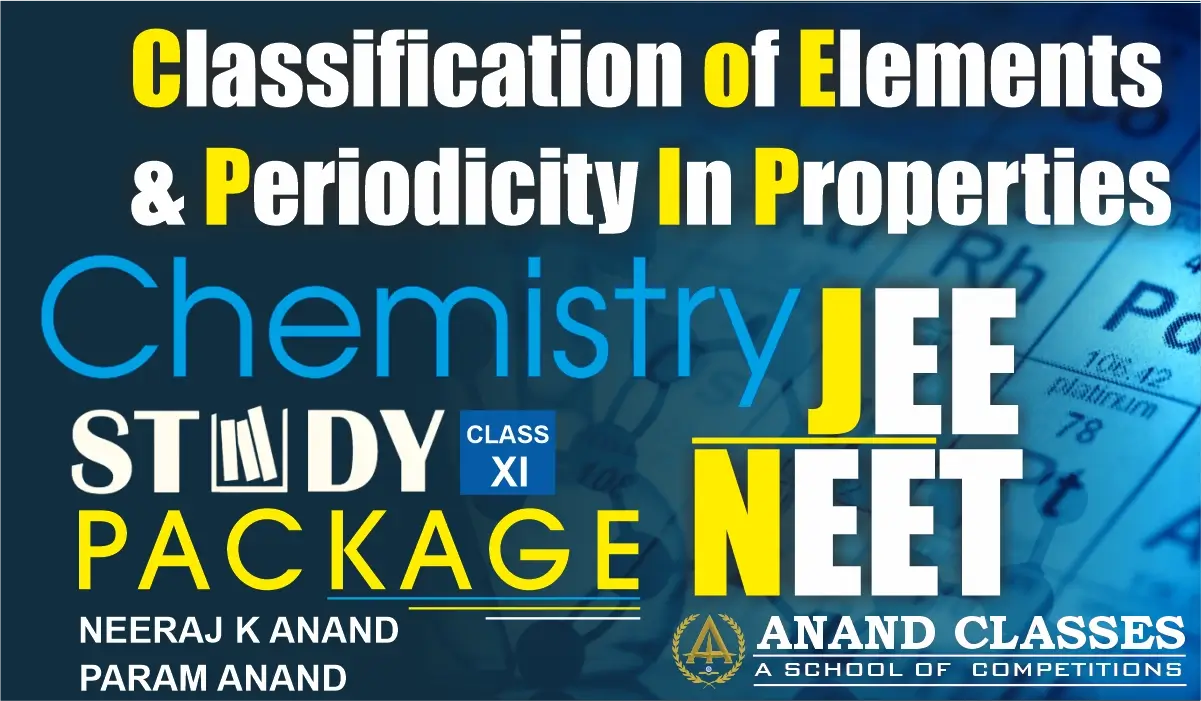Anand Classes explains that the electron gain enthalpy of second-period elements (such as N, O, F) is generally less negative than their third-period counterparts (such as P, S, Cl). This trend arises because second-period elements are very small in size, and when an extra electron is added, it experiences strong electron–electron repulsions in the compact 2p orbitals. In contrast, third-period elements have larger atomic sizes and more diffused orbitals, so the incoming electron experiences less repulsion and greater attraction from the nucleus, resulting in more negative electron gain enthalpy values. This concept is important for JEE, NEET, and CBSE Class 11 Chemistry as it explains anomalies in periodic trends.
Why Third Period Elements Have More Negative Electron Gain Enthalpies than Second Period Elements
General Statement
- In many cases, the third-period elements (P, S, Cl) have more negative electron gain enthalpies than their corresponding second-period elements (N, O, F).
- Example:
- Nitrogen (N): –7 kJ/mol (almost zero, since its half-filled p³ is stable)
- Phosphorus (P): –48 kJ/mol (more negative than N)
- Oxygen (O): –141 kJ/mol
- Sulphur (S): –200 kJ/mol (more negative than O)
- Fluorine (F): –328 kJ/mol
- Chlorine (Cl): –349 kJ/mol (more negative than F)
Reason: Smaller Size of Second Period Atoms
- Second-period atoms (N, O, F) are extremely small in size.
- When an additional electron is added, it has to enter a very compact 2p orbital.
- This compact orbital is already crowded with electrons → the new electron faces strong electron–electron repulsions.
- Due to this repulsion, the attraction of the nucleus is not felt strongly, and hence less energy is released (ΔegH is less negative).
More Electron Gain Enthalpy of Third-Period Atoms
- Third-period atoms (P, S, Cl) are larger in size compared to second-period atoms.
- The incoming electron enters the 3p orbital, which is more diffused and spacious.
- As a result:
- Repulsion between electrons is less.
- The incoming electron can be accommodated more easily.
- The nucleus can exert a stronger net attraction.
- Hence, more energy is released → ΔegH becomes more negative.
Special Case: Fluorine
- Fluorine is the smallest atom in the group.
- Its 2p orbital is extremely compact.
- Adding an extra electron here produces very high inter-electronic repulsion, more than in any other element.
- That’s why the anomaly is most pronounced in fluorine, whose electron gain enthalpy is less negative than chlorine, despite fluorine being more electronegative.
Key Conclusion
- The difference between second and third period elements is mainly due to atomic size and repulsion effects.
- Second-period atoms → small size, high repulsion, less negative ΔegH.
- Third-period atoms → larger size, less repulsion, more negative ΔegH.
- This is an important exception to the simple rule of “smaller size = more negative electron gain enthalpy.”
✅ Exam Tip: Always remember — Second-period elements (N, O, F) often show less negative electron gain enthalpies than expected, when compared with their third-period counterparts (P, S, Cl).
📘 Conceptual Examination Questions on Electron Gain Enthalpy (2nd vs. 3rd Period)
Q1. Why is the electron gain enthalpy of oxygen less negative than that of sulphur?
Answer:
- Oxygen is a second-period element with a very small atomic size.
- The extra electron must enter a compact 2p orbital, where it faces strong electron–electron repulsions.
- In sulphur, the incoming electron enters the larger 3p orbital, which is more spacious and experiences less repulsion.
✅ Therefore, sulphur releases more energy (ΔegH = –200 kJ/mol) than oxygen (ΔegH = –141 kJ/mol).
Q2. Between nitrogen and phosphorus, which has more negative electron gain enthalpy? Explain.
Answer:
- Nitrogen: Its electronic configuration is 1s² 2s² 2p³, i.e., a half-filled stable p³ configuration. Adding one more electron disturbs this stable arrangement, so its ΔegH is almost zero (–7 kJ/mol).
- Phosphorus: Electronic configuration 3s² 3p³. The larger size and less repulsion in 3p orbitals allow easier acceptance of an extra electron.
✅ Thus, phosphorus has a more negative electron gain enthalpy than nitrogen.
Q3. Why do second-period elements (N, O, F) have less negative electron gain enthalpy values than their third-period counterparts (P, S, Cl)?
Answer:
- Second-period elements are very small.
- When an additional electron is added, it faces large electron–electron repulsions in compact orbitals.
- In contrast, third-period elements have larger atomic size and more diffused orbitals, so repulsion is less, and nucleus attraction dominates.
✅ Hence, third-period elements have more negative electron gain enthalpies.
Q4. Assertion–Reason Type
Assertion (A): The electron gain enthalpy of chlorine is more negative than that of fluorine.
Reason (R): Fluorine has a very small size, and the incoming electron suffers strong repulsions in the compact 2p orbital.
Answer: ✅ Both Assertion and Reason are correct, and Reason is the correct explanation of Assertion.
Q5. Arrange the following elements in order of increasing negativity of electron gain enthalpy: N, P, O, S, F, Cl.
Answer:
Order: N < P < O < S < F <Cl
- N ≈ 0 (stable half-filled p³)
- P < O (O smaller, more repulsion)
- S > O (larger, less repulsion)
- Cl > F (fluorine anomaly due to small size and repulsion).
Q6. Why does nitrogen have almost zero electron gain enthalpy?
Answer:
- Nitrogen has the configuration 1s² 2s² 2p³, a half-filled p-orbital (stable configuration).
- Adding one more electron would disrupt this stability, and the extra electron would face high repulsion in the compact 2p orbital.
✅ Hence, nitrogen’s electron gain enthalpy is almost zero.
📚 Buy Study Material & Join Our Coaching
For premium study materials specially designed for JEE, NEET, NDA, and CBSE/ICSE Classes, visit our official study material portal:
👉 https://publishers.anandclasses.co.in/
To enroll in our offline or online coaching programs, visit our coaching center website:
👉 https://anandclasses.co.in/
📞 Call us directly at: +91-94631-38669
💬 WhatsApp Us Instantly
Need quick assistance or want to inquire about classes and materials?
📲 Click below to chat instantly on WhatsApp:
👉 Chat on WhatsApp
🎥 Watch Video Lectures
Get access to high-quality video lessons, concept explainers, and revision tips by subscribing to our official YouTube channel:
👉 Neeraj Anand Classes – YouTube Channel


